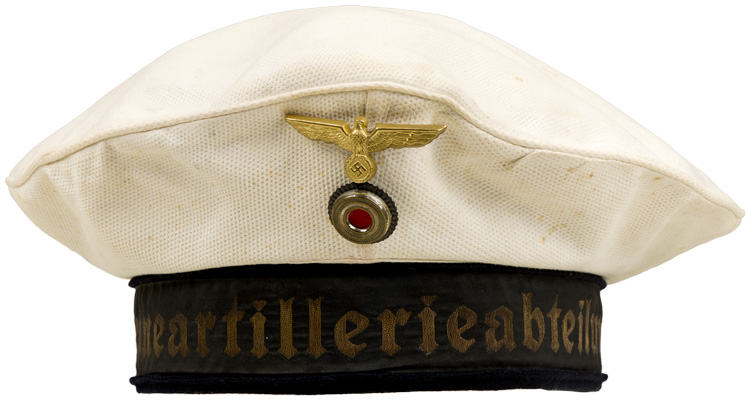

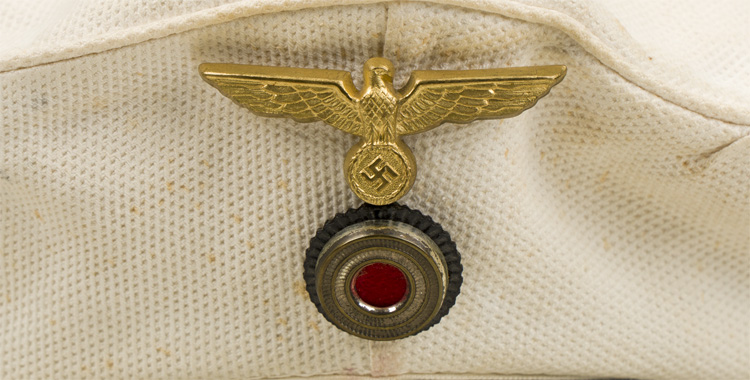
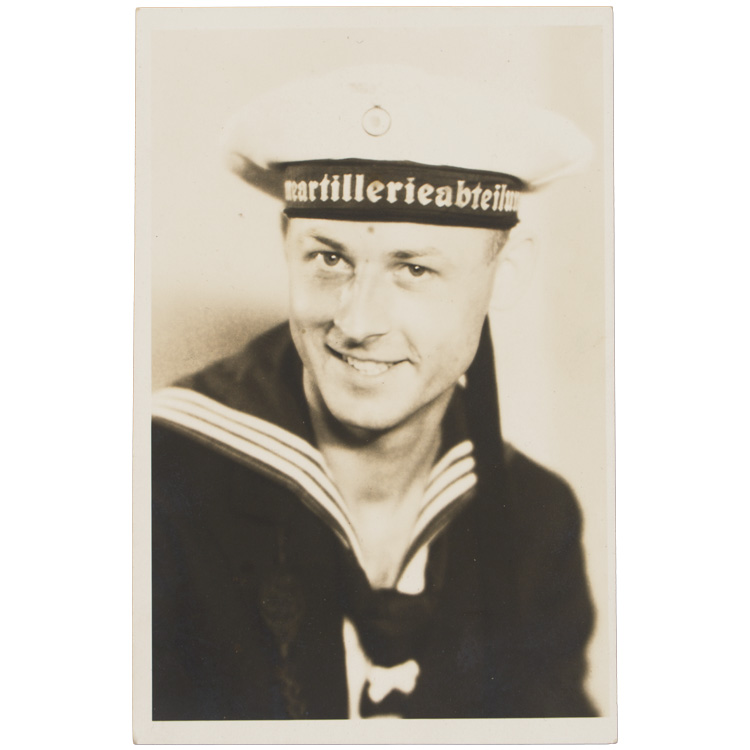
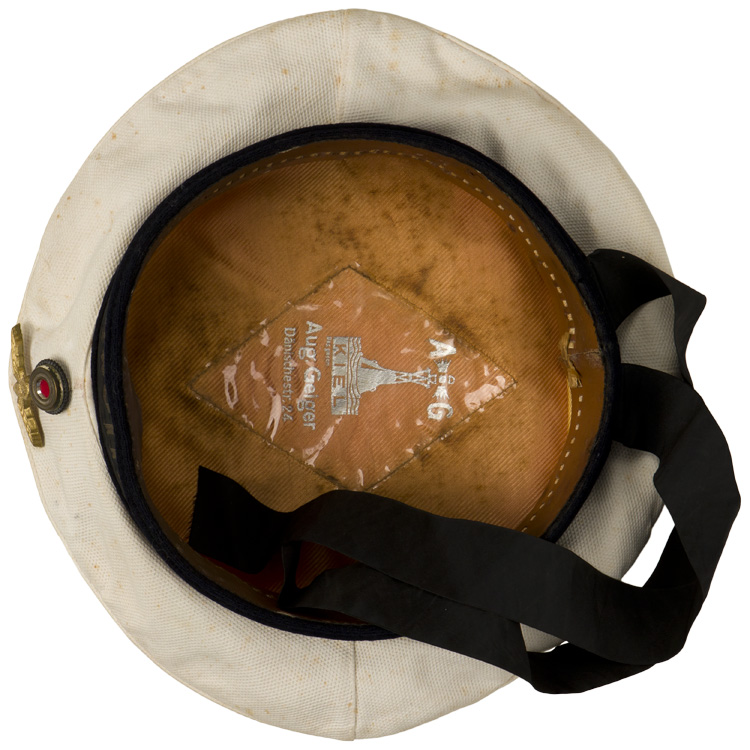
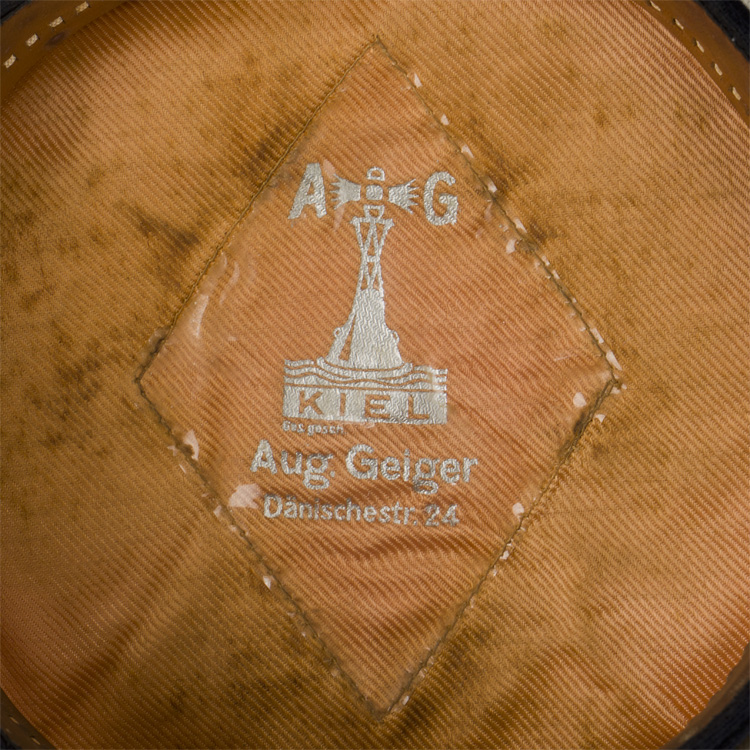
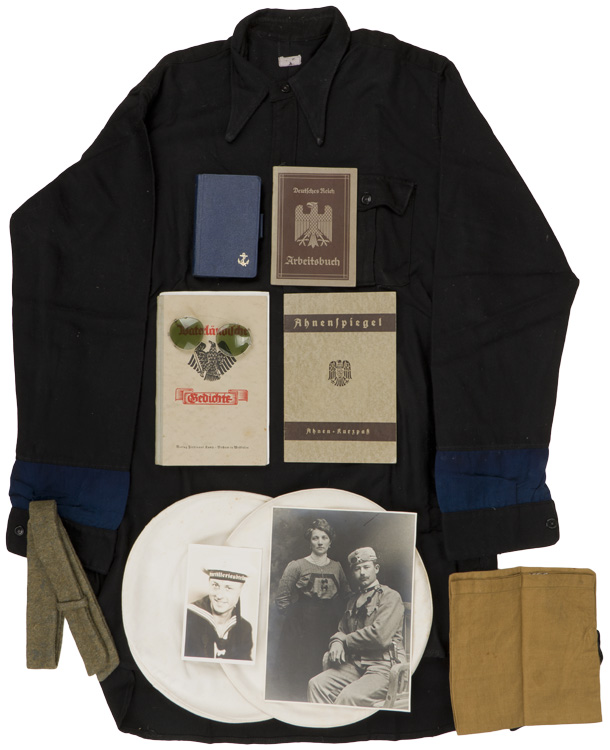
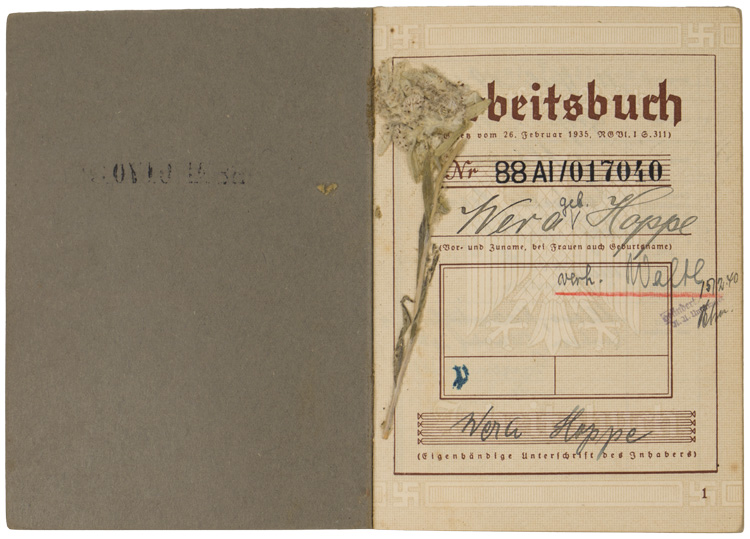
K000294 "DONALD DUCK" CAP, CLOTH & PAPER GROUPING. (Kriegsmarine Gruppe)
A fourteen-piece grouping, all from the estate of one Kriegsmarine veteran, consisting of his "Donald Duck" cap with two extra covers and a period photograph of him wearing it, a postcard from a military hospital, the employment record book of his wife, a book of poetry with National Socialist themes, an ancestry pass tracing his family lineage, a navy date book, a dark blue wool shirt and a field grey wool belt, sunglass lenses, a cotton sack, and a first world war era photograph of his father and mother. The German "Donald Duck" sailor’s cap ("Mannschaftsmütze" (Enlisted-cap), "Tuchmütze" (Cloth-cap), or "Dienstmütze" (Service-cap)) was based on traditional designs that date back to the creation of the Prussian Navy in 1848. The cap underwent numerous minor modifications during the intervening years, including the introduction of a cap with removable, interchangeable, white and blue covers in 1926. In 1931 a final pattern was established that remained in use until the end of WWII, with the only alterations then being to the insignia and cap tallies worn. The Weimar Reichswehr era oval cockade (in black, red and gold) was replaced with a new, circular cockade (in black, white, and red) in 1933. In 1934 the Kriegsmarine adopted a new national eagle on the front of the headgear and to the right breast of the uniform. 1936 regulations replaced the previously used gilt wire thread for the script on the cap tallies with golden yellow celleon threads, and in 1938 the "Kriegsmarine" titled cap tally was introduced for wear as a security measure in the case of mobilization; with the wear of named cap tallies restricted to barracks and on ships only if there was no possibility of them being seen by outside personnel. Additional regulations in mid-1940 withdrew all named cap tallies from further wear, to be replaced with the "Kriegsmarine" cap tally, for the duration of the war. The cap’s 11 1/2" diameter white canvas crown has the stitched outline of a name tag visible to its exterior center, and has 2 1/4" deep sides with seams to each of its cardinal points. The front center of the cap has fixed to it a stamped alloy, fire gilted national eagle, slightly convex and with a 2" wingspan, to which is connected a three-piece national tri-color cockade with a 7/8" diameter base. The eagle retains all of its fire gilting, with minor age dulling. The three-piece cockade consists of a black fluted base, and a silver-washed alloy roundel with a red felt dot to its center. Approximately 40% of the silver wash remains to the roundel. A 1 3/4" rifled vertical pin descends from the hollow back of the head of the eagle. Soldered to the hollow back of the wreathed swastika is a vertical tab with perforations which accepts the dual prongs to the back of the cockade. Stamped to this alloy tab is "D.R.G.M.," for "Deutsches Reichsgebrauchsmuster" (German Registered-design). The approximately 1 1/2" black headband has a 1 1/4" black silk cap tally with the machine woven Gothic script "Marineartillerieabteilung" (Marine-Artillery-Section), in gilt wire threads, to it. The horizontal cap tally has a vertical seam to its reverse to either side of which descend 16" vertical "tails" in the same width and of the same material as the tally. The ends of each of these "tails" are cut diagonally. The interior of the cap is fully lined in copper-colored rayon and features, to the center of its crown, a celluloid sweat diamond underneath of which is stamped, in silver, a light-buoy with "A" and "G" to either side of its light and "KIEL" to its base. "Ges. gesch." ("Gesetzlich geschützt;" protected by law) and the manufacturer’s name and address, "Aug. Geiger Dänischestr. 24," is beneath the image. The 1 3/4" brown leather sweatband has a white ribbon threaded through the numerous small vertical slashes above and along its edge and is tied to the reverse. An approximately 7 1/4" x 1/2" horizontal section of cork is beneath the sweatband to both the front and rear. The original wire stiffener may be seen along the interior circumference of the crown. Light age soiling is evident to the white cover, the inscription to the tally has lost its luster, one of its "tails" has two small holes to it, the interior crown is lightly soiled and has two small holes to it, and the interior sweatband has noticeable wear and soiling to it. Each of the cap’s two extra white canvas covers have approximately 11 1/2" diameter crowns and 2 1/4" deep sides with seams to each of their cardinal points. One has stitch outlines to the center of the interior crown, where a name tag was evidently removed. The other retains its original stiffening "wire," of some sort of flexible softwood, which runs along the circumference of the crown. Both of the covers exhibit light age soiling, with some noticeable small spotting, but retain all of their original stitching. Also included is a 3 9/16" x 5 1/2" black-and-white portrait photo postcard of the smiling original owner, in uniform, wearing the very same cap. To its reverse are lines for an address, "Fotohaus Petrykiewicz, Villach-Millstatt," and an indecipherable, handwritten pencil annotation. Slight age yellowing is visible, but the card is in otherwise excellent condition. Next in the grouping is a 4 1/8" x 5 3/4" printed paper postcard to whose obverse is the sepia-toned illustration of a sea-side arching road with two defensive towers and several smaller buildings along its route. "Wachen Und Warten Abwehren Und Abschiessen" (Watching And Waiting Warding-off And Shooting-down) is printed to the base of the illustration, and "Tag der Wehrmacht 20./21. März 1943" (Day of-the Armed-forces 20./21. March 1943) is inkstamped to its top. To its reverse is printed "Feldpost," beneath which are lines for an address, and "Mar. Erholungsheim Oberweissbach" (Marine Convalescent-home Oberweissbach) is inkstamped vertically to the left. Light age yellowing and very light age soiling may be seen. A first pattern, 4 1/8" x 5 7/8", 32 page employment record booklet follows, which features, to its brown and grey cardstock cover, "Deutches Reich" above and "Arbeitsbuch" beneath a stylized eagle. Swastikas may be seen to each of the four corners. To the first page, entitled "Arbeitsbuch (Gesetz vom 26. Februar 1935, RGBl. I S.311)," is the book’s number and the individual’s name and signature. The second page details the individual’s personal information. The third page, entitled "Berufsausbildung" (Vocational-development), outlines their professional training and the fourth page, entitled "Bisherige Beschäftigungsarten von längerer Dauer" (Hitherto Employments of long Duration), their work history prior to that recorded in this book. To the fifth page is the issuing authority’s stamps and signature. The following twenty-four pages chronicle the individual’s work history, with only the first four pages, dated from 1932 to 1943, filled out in this case. Among the employments indicated are those with the "IV. Marine-Artillerie-Abteilung Verwaltung" (4th Marine-Artillery-Section Administration), the "Marine=Standortverwaltung" (Marine=Garrison-administration), and the [Marine-] "Festungsbaudienststelle" (Marine-Fortress-building-service-place), all out of Cuxhaven. Pages thirty to thirty-two are blank, although all of the interior pages have a shadow-printed repetition of the eagle, titles, and swastikas as seen on the cover as their backdrop. To the reverse cover is a space for the individual’s signature above "Arbeitsbuch" and the printer’s logo. Light age and usage soiling is evident, and there is a pressed Edelweiss to the inside cover. Next is a 5 1/2" x 8 1/4", hardcover, 48 page book which features, to its off-white cover, a black eagle with a sword in one of its talons between the red title "Vaterländisch Gedichte" (National Poem). The publisher’s name and address is to the base of the cover. A subtitle to the title page indicates that this is "Eine Sammlung für die deutsche Jugend" (A Collection for the german Youth). To the next page is the handwritten note, in Sütterlin script, "Kriegsweihnacht 1942" (War-Christmas 1942), with an indecipherable line beneath it. The opening section is entitled "Unter der Fahne" (Under the Flag) and begins with a quotation from Hitler (being the closing from his address to the Hitler Youth during the 1934 Nürnberg rally, as documented in "Triumph of the Will"). "Mein Vaterland ist Deutschland" (My Native-country is Germany), "Uns leuchtet Langemarck" (Ourselves light Langemark), "Du sollst an Deutschlands zukunft glauben" (You shall in Germany’s future believe), "Ein junges Volk steht auf" (A young People stand up), and "Werkgemeinschaft - Wehrgemeinschaft" (Work-community - Defense-community) comprise the remaining sections. Poems and aphorisms by Hitler, Friedrich von Schiller, Johann Gottlieb Fichte, Dietrich Eckart, and Baldur von Schirach are among the seventy-two entries within. An index and a listing of books by many of the included authors are to the final pages. Light age soiling is to the covers, and light fingerprints may be seen to some of the pages, otherwise, the book is in excellent condition. Continuing the grouping is a 5 1/2" x 8 1/4", soft cover, 26 page booklet to whose grey cover are two horizontal brown bands, with "Ahnenspiegel" (Ancestry-reflection) to the top one and "Ahnen=Kurzpaß" (Ancestry=Short-pass) to the other. An eagle, with "R," "D" within a circle, "D" within another circle, and "S" to its shield-shaped breast, is between the two aforementioned bands to the center of the cover. The inside page has perforations along its edge and is entitled "Geburtsurkunde" (Birth-document), with the appropriate indicated spaces, all left blank, for personal information and official entries. The title page repeats the two headings to the cover, with "Herausgegeben vom Reichsverband der Standesbeamten Deutschlands E.V., Berlin" (Published by-the State-association of-the Civil-magistrates [of] Germany Registered Organization ["Eingetragener Verein"], Berlin) and a listing of applicable regulations beneath. The second numbered page is a notice, opposite of which is filled in the bearer’s name, town, address, signature, a February 1939 date and several official, Kriegsmarine, stamps. The fourth page is entitled "Staatsangehörigkeit und Reichsbürgerrecht" (Citizenship and State-civic-rights), but is not filled out. The following three pages detail regulations concerning marriage, engagements, armed forces and labor service, health examinations, and applications by foreigners. Remarks about the organization of the ancestry-pass is also included. Page eight is entitled "Der Inhaber und sein Ehegatte" (The Bearer and his Spouse) and has the bearer’s name and personal information filled out with official stamps and signatures. Page nine is entitled "Die Eltern" (The Parents) and has its three sections similarly filled out and stamped. Pages ten, eleven and twelve all fold out from page nine and feature four elongated sections for "Die Großeltern" (The Grand-parents) filled out and stamped. To the opposite side of these pages are spaces for entries concerning "Die Urgroßeltern" (The Great-grand-parents) and "Ergänzungsbescheinigungen" (Supplementary-certificates), all left blank. The last six pages are comprised of short articles addressing "Der Rassegrundsatz" (The Race-principle), "Die Begriffe: ‘Deutsches oder artverwandtes Blut’ und ‘arische Abstammung’" (The Idea: "Germans or related-stock Blood" and "aryan Descent"), "Der Abstammungsnachweis" (The Descent-evidence), "Die Ahnenaufstellung (Ahnentafel)" (The Ancestry-arrangement (Ancestry-table)), "Die Beschaffung der Urkunden" (The Procuring of-the Documents), and "Die einzelnen Abstammungsnachweise" (The single Descent-evidence). Another page with a perforated edge, entitled "Heiratsurkunde" (Marriage-document), completes the work. It too is left blank. Light age and usage soiling is evident. Of Note: It was required of all Germans to complete a history of their lineage, with verifications and stamps, to seven generations; the point being to prove and record the Aryan ancestry of a single individual. A 3 1/4" x 5", hardcover, 434 page book follows, upon whose navy blue leatherette cover is impressed, to the lower right, a golden fouled anchor. "1937" is impressed, also in gold, to the top of its spine. The opening end-papers are comprised of a photograph of Hitler in a visor cap and greatcoat with a group of high-ranking military officers following him, including Field Marshal von Blomberg and Admiral Raeder, and ranks of sailors presenting arms in the background. The title page features a fouled anchor with "Der Soldatenfreund" (The Soldier’s-friend), "Ein unentbehrlicher Ratgeber im Dienst des Soldaten, zugleich Taschenkalender für die Wehrmacht" (An indispensable Advisor in-the Service of-the Soldiers, at-the-same-time Pocket-calendar for the Armed-forces), and "1937" beneath it. The indication that this is the Kriegsmarine edition is also to this page, and a photograph of Hitler shaking hands with von Blomberg, while Göring, von Fritsch and Raeder look on, is to the facing page. A brief introduction by von Blomberg is to the next page, and a publisher’s forward follows. Most of the book is comprised of articles which include the duties of the German soldier, "Waffenfarbe" (branch-of-service colors) of the army and air force, a history of the German navy (with numerous illustrated charts chronicling important battles), a listing of naval officers who had won the "Pour le Mérite," an illustrated listing of all ships in the fleet, illustrated articles on sea-lane navigation, buoys, lighthouses, knots, weather, morse code and semaphore, measurements, and much more. A 110 page calendar follows, starting with November of 1936 and ending with March of 1938, which has mostly indecipherable handwritten entries starting in June of 1937 and ending in October of the same year. Of particular interest are the last thirty-two pages, which are color charts of various German flags, awards, uniforms and rank insignia of the Heer, Kriegsmarine, Luftwaffe, Polizei, SS, SA , NSDAP, NSKK, RLB, RAD, HJ, DJ and BDM, more German flags, war-flags of other nations, aircraft markings of various nations, selected national flags of the world, German merchant marine flags, and international signal flags. The closing end-papers, over half of which is a grey oilcloth folder pasted to the inside of the back cover, are comprised of a photograph, taken most likely from the bridge, of the prow of a battleship with twelve U-Boats arranged in three groups along the dock beyond it. A loop of material in the same color as the covers is along the edge of the back cover, undoubtedly for a pen or pencil. Slight age yellowing is to the pages, but no other damage. A dark blue wool shirt is next, whose arms have been extended by means of 3" extensions above each cuff in a similarly-colored but different material. It features a two-button plaquette front closure with a lay-down collar with exaggerated tips, a pleated patch pocket to the left breast with a scalloped single-button flap, and single-button closures at each of the cuffs. A pleat is to the upper back and each hip has vertical slashes to them. A small, white cotton tag, which most likely originally had a name to it, is sewn to the interior rear of the collar. Age and usage soiling may be seen, but no tears or repairs. The grouping continues with an approximately 1 1/2" x 34", dual-ply green-grey wool belt with angled ends and a fixed retaining loop of the same material. Moderate nap wear is evident, but no moth nips, tears or repairs. Following is a pair of dark green lenses with thin alloy frames, and joined by a thin alloy bar, meant to be fitted, by means of the dual hooks to either outside edge, over a pair of glasses. To the right lens, immediately underneath where the bar is connected to it, is a small chip. Age darkening may be seen to the alloy bar and frames. Next is an approximately 7 1/4" x 14 3/4" khaki-colored cotton sack with two 7" black cotton tie-strings sewn to its side seam, 2 3/4" down from its open top. A small white cotton tag with the original owner’s name written to it in black is sewn just inside the top opening. Some light soiling is evident and there is an almost unnoticeable wear spot three-quarters down to one side. The final item in the grouping is a 7" x 9 1/4" black-and-white portrait photograph of a first world war era Austrian mountain troop, in uniform, seated alongside a standing woman. To his wooly cap is a button with what appears to be "FR" stamped to it, underneath of which he wears snow goggles, two stars are to each side of his two-toned stand-up collar, what must be a marksman’s lanyard is buttoned to his left shoulder strap and is draped across his breast, and a bayonet is slung from his belt. "Agfa-Brovira" is repeatedly lightly stamped to the otherwise unmarked reverse. A single mark to the upper right of the obverse is the only distracting feature. A very interesting, and varied, grouping in very good condition.
GRADE *** 3/4 PRICE $2,380.00
To Order this item, please use one of the two e-mail addresses below to contact us. Please make sure to quote the item number in your e-mail
MILITARIA WANTED! If you have items for sale, please contact us. We specialize in selling single pieces and entire collections. Over 3 decades in the business and we do all the work for you. Get the best return for your investment.
-E-Mail Address pawmac@nbnet.nb.ca Or guild@nb.aibn.com
To return to the main page please CLICK below